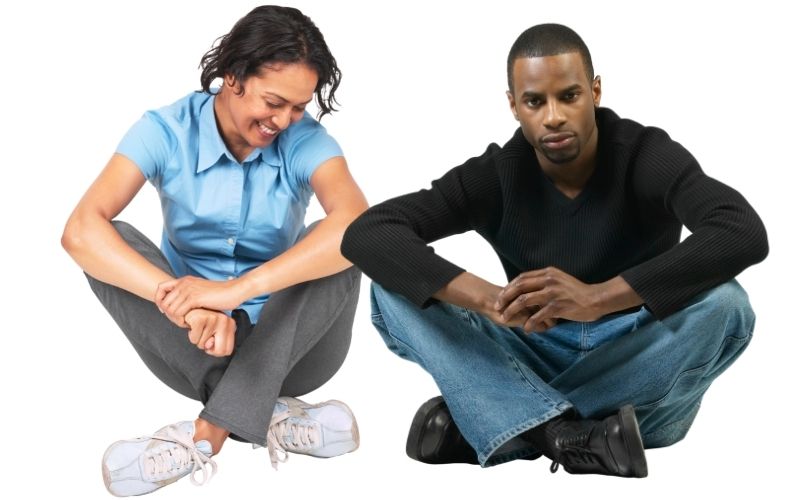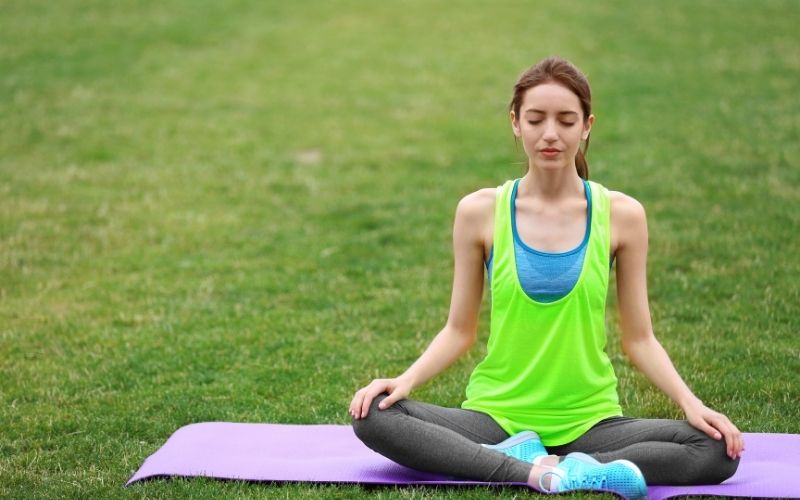We all have fond memories of sitting cross-legged as a kid, be it while playing games, in front of the TV watching our favorite cartoons, or even in the classroom. But, as adults, sitting cross-legged can seem like torture for many.
Do you too find yourself struggling to sit cross-legged? Don’t worry, you are not alone.
You may have felt a pinching sensation, some numbness, even unbearable pain that deters you from sitting cross-legged. If so, there are plenty of reasons that may be causing that. Weak thighs and glutes, old age, weak pelvic muscles, tense muscles, poor blood circulation are some factors that can create difficulties while trying to sit cross-legged.
In this article, we discuss the most common reasons that may be stopping you from sitting cross-legged, along with exploring some unique exercises and tips you can start implementing to see a positive difference in your body and your sitting habits.
Table of Contents
Why Can’t I Sit Cross-Legged?
If you have been unable to sit cross-legged, it is an indication that you need to pay more attention to your body. Not being able to sit cross-legged can be a sign of an unhealthy lifestyle as well as severe factors that can be life-threatening in the long run.

Poor Thighs And Pelvic Muscles
If you have constant back pain, discomfort in your genitals, trouble during urination, or a restrained bowel movement, chances are you probably have weak thighs and pelvic muscles. When both the thighs and pelvic muscles are weak, you will face trouble sitting in a cross-legged position for too long.
Affected Hip Mobility
The tightening of hip muscles due to lack of movement, inflammation, or sitting in one position for too long can affect your hip’s mobility and prevent you from sitting cross-legged.
Poor Circulation Of Blood
Poor blood circulation is known to make your muscles feel stiff. And when the muscles are rigid and tightened, the lower body weakens over time, thus affecting your ability to sit down in a cross-legged position for too long.
Weak Glutes And Arches
When you sit in a cross-legged position, most of your body weight lies on your glutes. So if your glutes and arches are underdeveloped and weak, your lower body will feel numb whenever you try to sit with your legs crossed.
How Do You Get Flexible Enough To Sit Cross-Legged?
One of the leading causes of lack of flexibility in our bodies is an inactive and sedentary lifestyle, one that most of us live when we are confined to our office chairs. This is also what inhibits us from sitting cross-legged.

1. Exercise
Regular exercise is the first step to improving your overall health and thus helping your body become more flexible. If you have a desk job, you need to ensure that you are exercising at least 3 to 4 days a week for an hour each. You can seek the help of a trainer or a physical therapist who can design a flexibility program according to your body requirements.
2. Static Stretching
Include static stretches in your routine. A static stretch means holding your body in a particular posture for 30 seconds to a minute. Do it multiple times a day to see quick, effective, and long-lasting results.
3. Dynamic Stretching
Along with static stretching, dynamic stretching is equally important. It engages all your core muscles simultaneously, loosens them, and makes your body more capable of stretching.
How Do I Loosen My Hips To Sit Cross-Legged?
When there is tension across the hip flexors, which is a critical group of muscles that helps the locomotion of your lower body, your hip tends to develop tightness. And tight hips make it significantly more difficult to sit cross-legged.
If you face such a problem, here are some easy ways that will help you loosen up your hips:
- Use a foam roller to release the muscle tightness in your hips. There is a self-myofascial release (SMR) technique that should be applied regularly to calm sore and tight muscles.
- Doing a butterfly stretch is one of the best movements you can do to improve the muscles in your lower body including your thighs and knees and open up your hip and groin area. Do this stretch for 30 seconds every day till you see an improvement in your tightened hips.
- Working a desk job with tight hips? Don’t worry! You can do some simple exercises, such as shoulder and neck stretches, seated leg raises, calf raises, and chair dips, while sitting in your office chair to relieve the pain.
- Yoga can be your best friend to get over a tight hip. There are some incredibly easy and result-yielding postures for you to try, some of which include a high crescent lunge, a four-figure stretch, cow face pose, and several more.
Benefits Of Sitting Cross-Legged
If you finally pull off sitting in a cross-legged position, which we are hopeful you will do if you follow the tips and guidelines mentioned earlier, you will be amazed to see the wonders it does to your body.

Here are some of the most beneficial outcomes of sitting cross-legged:
- You may have come across many people who prefer sitting cross-legged over any other sitting or standing position, especially when they’re at home. This is because once you become accustomed to sitting in a cross-legged position, you’ll find it incredibly comfortable.
- Did you know that eating your meals while sitting in a cross-legged position aids digestion? This is because the movement that is caused by leaning forward to eat your meal and coming back as you straighten your spine gently squeezes your stomach and signals the brain to produce acids that aid better digestion.
- Sitting on a chair for an extended period can pose several health hazards. Instead, when you sit cross-legged, you automatically encourage more movement in your body and mitigate the risk of several health ailments such as heart ailments, high blood pressure, and irregular cholesterol levels.
- Regularly sitting in a cross-legged position improves your body’s range of motion. It helps loosen up the muscles, helps you become more flexible, and improves your posture.
- Trouble with passing stool? Try sitting cross-legged to see a fantastic improvement in your bowel movement.
- Sitting cross-legged puts little to no pressure on your knees and joints.
- Cross-legged sitting leads to better circulation of blood throughout your body. In this position, more pressure is exerted on the arteries in your internal thighs, resulting in the heart pumping more blood and improving circulation.
- Cultivating the habit of sitting cross-legged right from the younger days helps your lower body become more robust, and you have more balance in your body as you grow older.
Conclusion

Sitting in a cross-legged position is not uncommon, especially nowadays when so many people practice yoga. However, for newbies, it can be quite uncomfortable at first.
Fortunately, there are many ways to address this issue, some of which we have addressed in this article. We hope you can now identify and rectify the issues that are stopping you from sitting cross-legged and take the necessary steps to keep your health in check.

My name is Vance, and I am the owner of To Ergonomics. Our mission is to improve your workflow by helping you create a supportive and welcoming environment. We hope that you’ll find what you’re looking for while you’re here.

